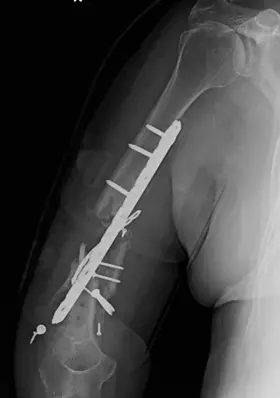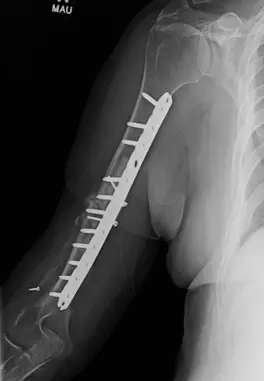- Home
- Patient Care
- Services
- Trauma/Fracture Care
- Overview
- Nonunions
Fracture Nonunion
What is a fracture nonunion?
When a bone breaks or fractures (broken and fractured means exactly the same thing), healing of the bone usually takes a few months to occur. A bone is considered healed or “united” when it is strong enough to allow normal activities. Depending on many factors, this can take as little as 4 weeks or as long as 6 months. When a fractured bone is not healed and there is little chance it will heal without further surgery, the fracture is then considered to be a “nonunion”. A “Delayed Union” is different than a nonunion. A delayed union means that the bone took or is taking longer to heal that expected, but it is expected to eventually heal without the need for additional surgery.
What factors affect bone healing?
1. Fracture Severity
The more severe a fracture is, the more likely it is to become a nonunion. Severe fractures are ones that occur from major trauma such as high-speed motor vehicle or motor cycle accidents. Less severe fractures typically occur from falls or twisting mechanisms. Physicians often call severe fractures “high energy” fractures and call less severe fractures “low energy” fractures. With high-energy fractures, the bone is often broken into many pieces while low energy fractures are usually only broken into two or maybe three pieces.
For example, a fracture caused by twisting an ankle would be considered a low energy fracture. The twisted bone usually breaks in a spiral pattern just like a piece of chalk would break if twisted. The reason high energy fractures have problems healing is related to the amount of damage done to the bone and the amount of damage done to the blood supply to the bone. All tissues in the body require blood supply to remain alive and heal. Severely damaged bone also has a damaged blood supply. This leads to bone healing slowly (delayed union) or never healing (nonunion).
Below is an example of a fracture that never healed properly (nonunion fracture). The first picture is the patient's nonunion fracture. The second picture shows the healed arm.


2. Infection
When a bone or fracture is infected, it is called osteomyelitis. An infection makes it difficult or impossible for the fractured bone to heal because the infection impairs bone development and may damage the blood supply. Infection kills the bone and the blood supply to the bone making healing nearly impossible. An infection of a fractured bone is called an “infected nonunion”.
Infected nonunions are extremely difficult and time consuming to treat. Usually, the first priority is to get rid of the infection. Once the infection is gone, getting a nonunion to heal is possible in almost all cases.
What makes our orthopedic trauma service different?
The Orthopedic Trauma Service at Washington University Orthopedics has extensive experience in treating the most severe fractures and nonunions, related to both high and low energy fractures. Our team also includes a subspecialist in bone infectious diseases who will customize antibiotic therapies to each patient’s specific infection.
More Information